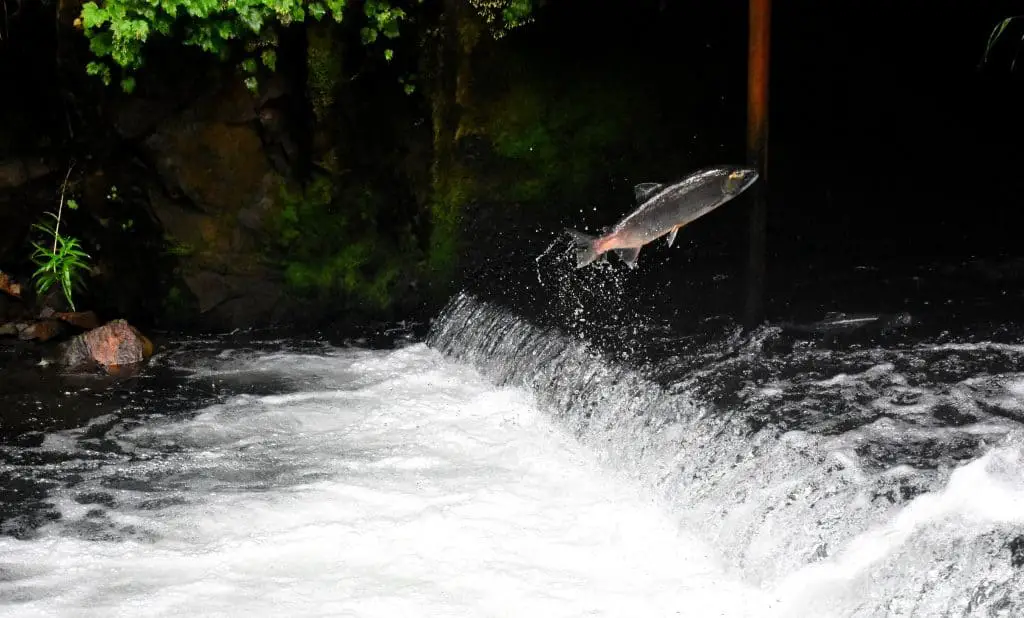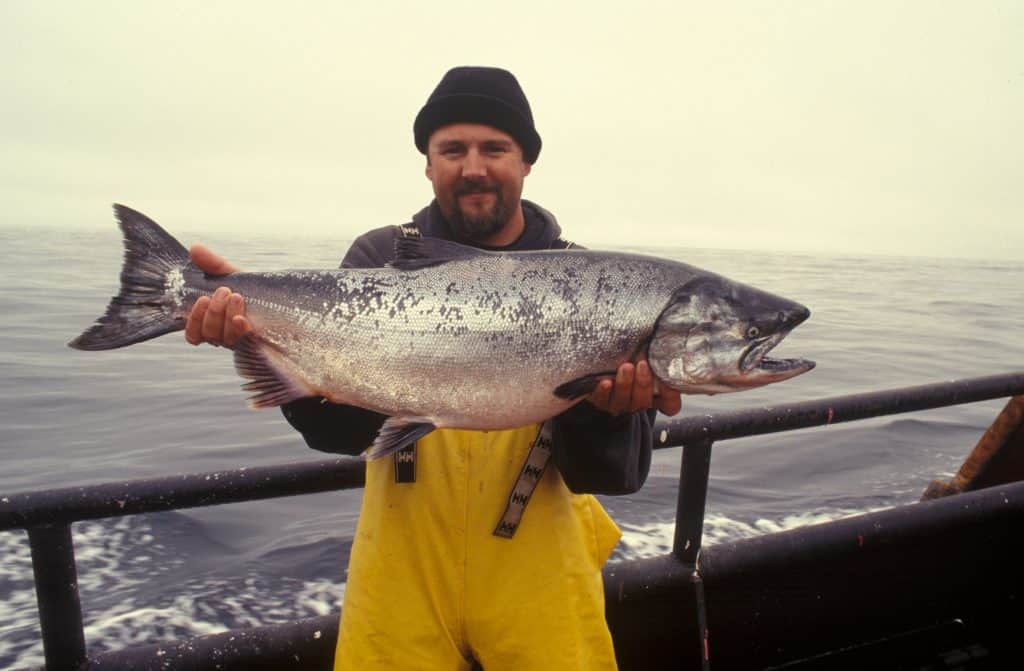Deep beneath the swirling currents of a north Pacific rip tide, a salmon lies, waiting for his next meal. The mature chinook is an eating machine, intent upon loading up on calories. Twenty feet above, a sparkling chrome flasher passes by. That’s not food. He’s not remotely interested.
Next, a red and white wooden plug zigzags overhead. He follows it a few feet. His fins begin to quiver. Suddenly, he turns away. Intuition tells him something is amiss. Then, he spies the one thing that always triggers his feeding instincts – a single herring, struggling to maintain its equilibrium in the current. The big chinook flares his gills, lunges, and inhales the hapless herring.
This scenario is replayed countless times a year from northern California to Alaska. Astute salmon anglers who have studied their prey know that nothing rings a salmon’s dinner bell better than a falling, fluttering bait or lure. Top salmon anglers focus on the two key ingredients for successfully tricking salmon – location and presentation.
If you can find the salmon and present your lure or bait in a way that imitates a struggling baitfish, success is virtually assured.

Salmon Fishing Locations
Where baitfish congregate, salmon will follow. The key to finding salmon is to understand where the baitfish will be found at each stage of the tide. Baitfish are at the mercy of the tides. They are swept along with the current and will congregate wherever the tides dictate. The lee side of underwater pinnacles, ledges and ridges are ideal places to look for baitfish and their accompanying salmon groupies.
Different from trout, salmon love to lay in the mellow currents behind underwater structure. From their soft water lair, salmon watch for baitfish sweeping past in the nearby fast water.
To make an intelligent guess as to where the baitfish will be, pay careful attention to the direction of the tide flow in relation to underwater structures. For example, you may note that the current is flowing parallel to the shoreline. In that case, look for a point or underwater ridge that obstructs the current flow. Baitfish will pile up against the obstruction. Salmon will be there to pick off the stragglers.
Tide rips are another prime baitfish congregating area. The strong current pushes bait along like commuters on a freeway. Salmon work the edges of this baitfish freeway, picking off stragglers or rushing into the bait school to snap up a mouthful of bait.
Presentation for Salmon
To achieve the perfect presentation to tempt a salmon attack, try and visualize what your bait is doing. Imagine a crippled baitfish swimming erratically, struggling to stay on course, then falling in a tortured, twisting spiral. Your job is to present your lure or bait in a convincing re-creation of this drama.
There are three top techniques for taking salmon – jigging, trolling and live bait fishing. Each can be adapted to increase your strikes by working hard to imitate the death throes of a crippled baitfish.
1. Jigging
Jigging is a deadly tactic that many salmon anglers seldom try. This is the most simple technique to master, and it provides a very realistic imitation of a falling baitfish. All you need to master this effective style of salmon angling is a decent depth finder, a selection of metal jigs that match the size, shape and color of the natural bait, a medium heavy jigging rod, such as the Penn Rampage Jigger and a good quality bait casting reel.
This technique is based upon the assumption that salmon will be wherever the bait is. Rather than troll aimlessly, the jigging crowd stows the fishing rod until they find bait. Any decent depth finder let you see the bottom and suspended bait balls while you cruise at speed of up to 30 knots.
With one eye on the depth finder, cruise until the screen shows a major bait ball. When the screen goes black from all the bait, you know you are in the right neighborhood. Salmon will be beneath the bait or on the up current side of the bait.
Stop when you are directly above the salmon, or where you think they should be. Drop your jig through the bait, keeping just enough tension on the reel to avoid a backlash. When a salmon grabs a falling jig, you often don’t feel any sort of strike. But you will notice that the line has gone slack. The instant you feel any slack, strike hard. It doesn’t take a salmon long to figure out that there are damn few calories in a lead jig!
Expert jiggers make no more than five unsuccessful drops through a bait ball before moving on. If salmon are present, you will usually have a hook up on the first three drops.
Not every bait ball has a pack of marauding salmon trailing them. If you don’t find fish, stow your rod, fire up the motor and go searching for the next bait ball.

2. Live Bait
In areas where live bait angling is popular, many start their day with a visit to the bait dock. Most guides and serious salmon anglers use reciprocating pumps to keep fresh sea water flowing through their bait tanks. The more casual anglers simply rig an ice chest with an overflow pipe fitted near the top. Fresh seawater is dipped into the tank before the herring are added.
The usual rig for fishing live bait consists of a salmon fishing rod and reel, a swivel, a slip sinker and a two-hook harness. On the hook, herring will usually stay frisky for twenty minutes or more if you hook them gently and are careful not to drag them through the water too fast. It’s important that your bait is lively.
The best weighting system for live bait fishing is a round lead fitted with a hollow plastic center tube. The main line is inserted through the lead which slides freely on the line. A swivel below the lead acts as a stopper.
For added control in placement of the lead, some guides force a toothpick between the line and the center of the lead. This allows placement of the lead as much as twenty feet from the bait giving the bait maximum freedom to roam and attract the attention of a salmon.
The top hook is placed through the clear membrane just in front of the herring’s eye. It’s important to keep this hook clear of the herring’s lower jaw so it can breathe naturally. The back hook is slipped just beneath the skin near the dorsal fin.
Typically when a salmon inhales a live bait, he immediately swims toward the surface. The rod tip, relieved of the pull of the sinker, will suddenly spring up. Now the fun begins. Reel like a madman until you catch up to the fish. If you are fast enough, you will soon feel substantial resistance.
Set the hook and brace yourself. If you aren’t fast enough on the uptake, or if Lady Luck isn’t on your side, you will never catch up to the surface seeking salmon. Check your bait and try again.
3. Trolling
Trolling for salmon has become the standard approach used by most west coast anglers. This is true in part because it often works well and in part because it’s the lazy man’s way to fish (no offense, I also enjoy using my Okuma Combo). Many salmon anglers make the mistake of randomly trolling without thinking about where the bait will be, and without varying their course or trolling speed.
Wherever salmon roam, they feast on various baits at different times of the year. Typically, salmon pursue the most prevalent bait they can find. The salmon’s favorite source of calories is herring, anchovies or candlefish. To consistently hook salmon, you need to find which food source the salmon are exploiting, then do your best to “match the hatch.”
It should be obvious that an anchovy would be the best bait to use when salmon in your area are keying on anchovies. Yet it’s amazing how many anglers stubbornly stick with herring even when they know the salmon are feeding on anchovies.
If you have herring for bait, it’s a simple matter to cut fillets and to shape them into a profile that resembles an anchovy. It’s usually close enough to trick feeding salmon. Those who have anchovies available will find that a plastic bait holder clip will give their anchovies an alluring roll, and it will keep them on the hook a long time.
When the salmon are keying on herring, you have many ways to match the hatch. Fresh or live herring are always preferable to frozen bait, but well cared for frozen herring will do the job almost as well.
Salmon Fishing Tips & Tricks: Happy Fishing!
We hope you enjoyed these salmon fishing tips & tricks and can take and use one or two for your next trip. Whether you will be jigging, using live bait or trolling for salmon, go with what’s most fun and follow these tips to maximize your chance of a successful trip!
And check out the salmonfishingforum for even more info on salmon, or our articles on bass, fluke, crappie or walleye and perch fishing tips & tricks!